1993 CADILLAC ELDORADO low beam
[x] Cancel search: low beamPage 109 of 398
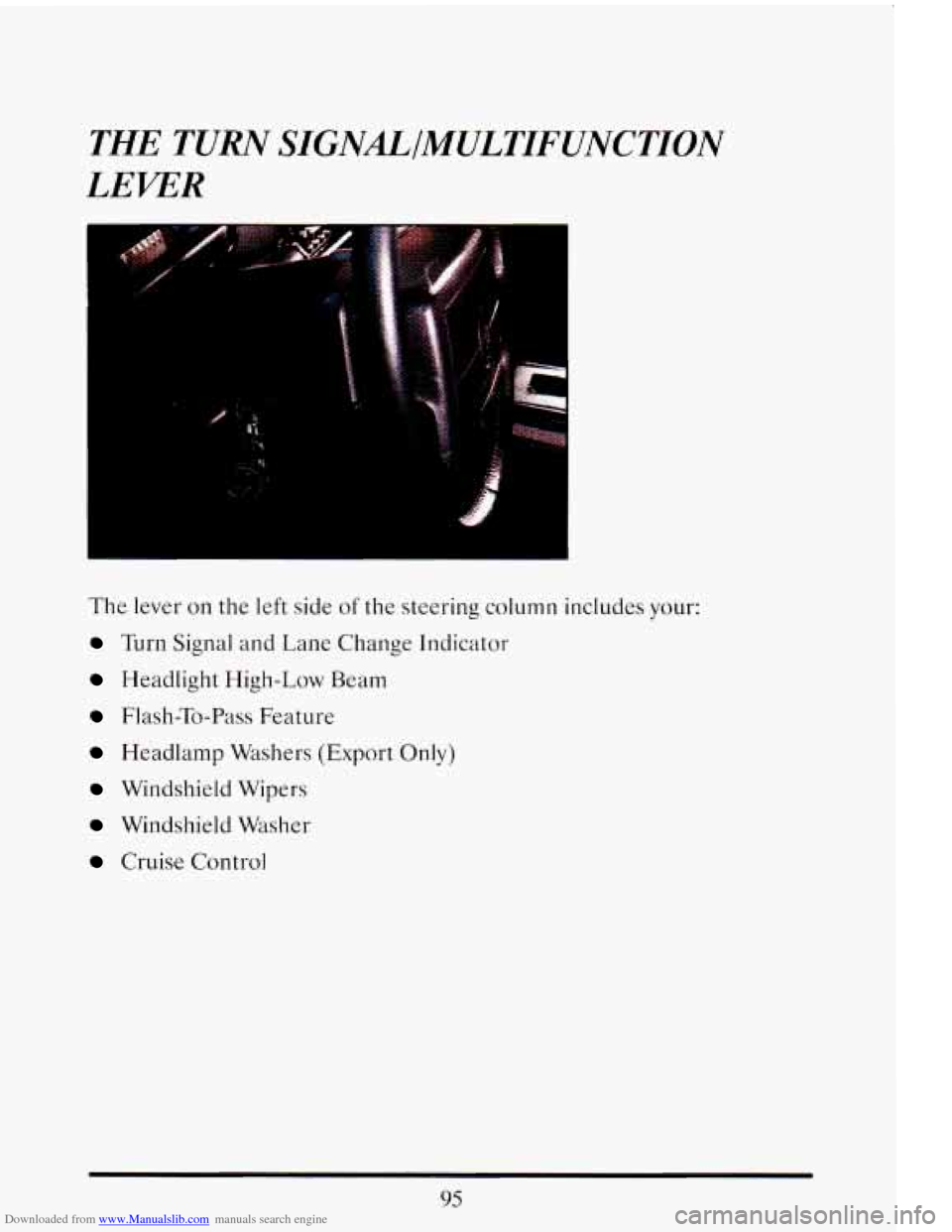
Downloaded from www.Manualslib.com manuals search engine THE TURN SIGNALIMULTIFUNCTION
LEPER
The lever on the left side of the steering column includes your:
Turn Signal and Lane Change Indicator
Headlight High-Low Beam
Flash-To-Pass Feature
Headlamp Washers (Export Only)
Windshield Wipers
Windshield Washer
Cruise Control
Page 111 of 398
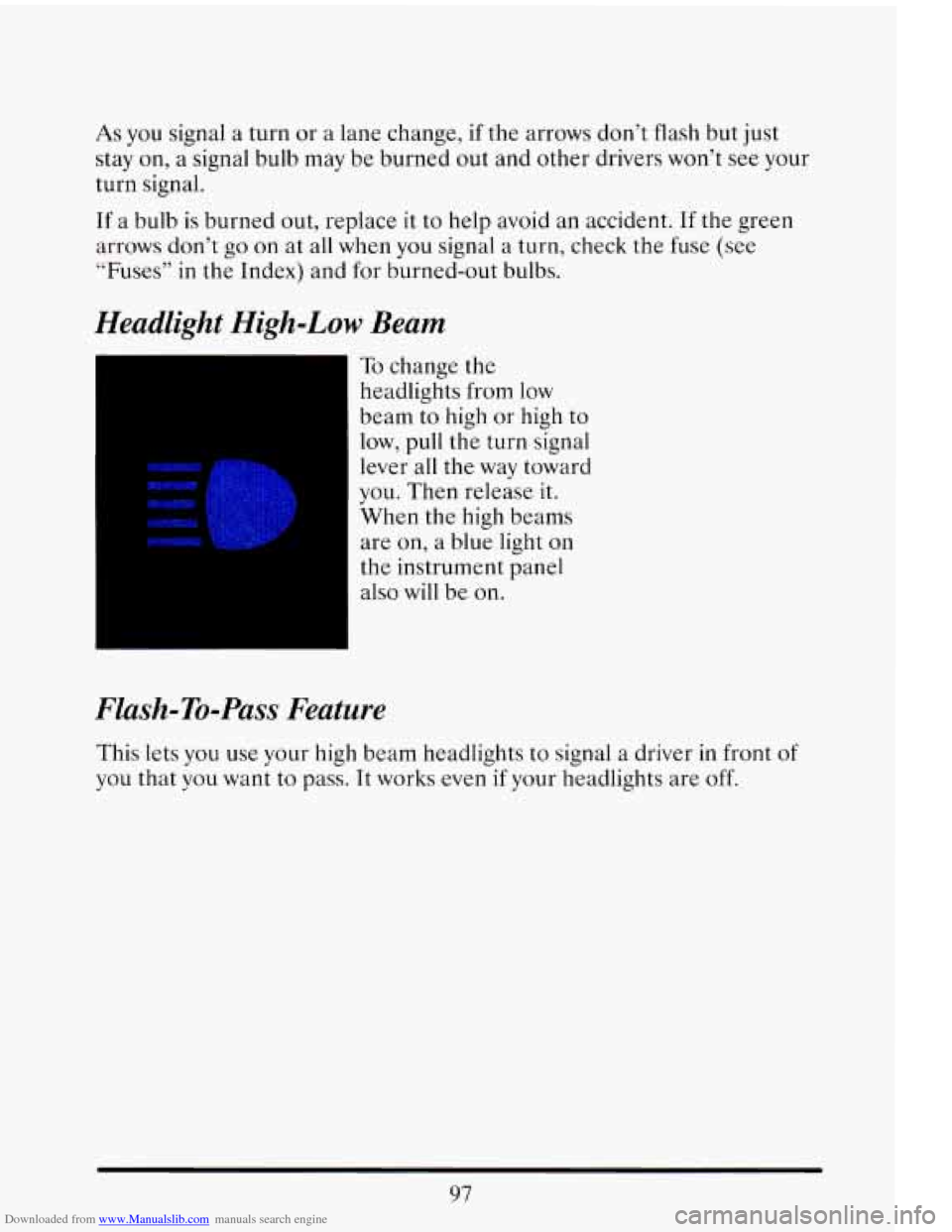
Downloaded from www.Manualslib.com manuals search engine As you signal a turn or a lane change, if the arrows don’t flash but just
stay on, a signal bulb may be burned out and other drivers won’t see your
turn signal.
If a bulb is burned out, replace it to help avoid an accident. If the green
arrows
don’t go on at ail when you signal a turn, check the fuse (see
“Fuses” in the Index) and for burned-out bulbs.
Headlight High-Low Beam
To change the
headlights from low
beam to high or high to
low, pull the turn signal
lever all the way toward
you. Then release it.
When the high beams
are on, a blue light on
the instrument panel
also will be
on.
Flash-To-Pass Feature
This lets you use your high beam headlights to signal a driver in front of
you that you want to pass. It works even if your headlights are off.
97
Page 112 of 398
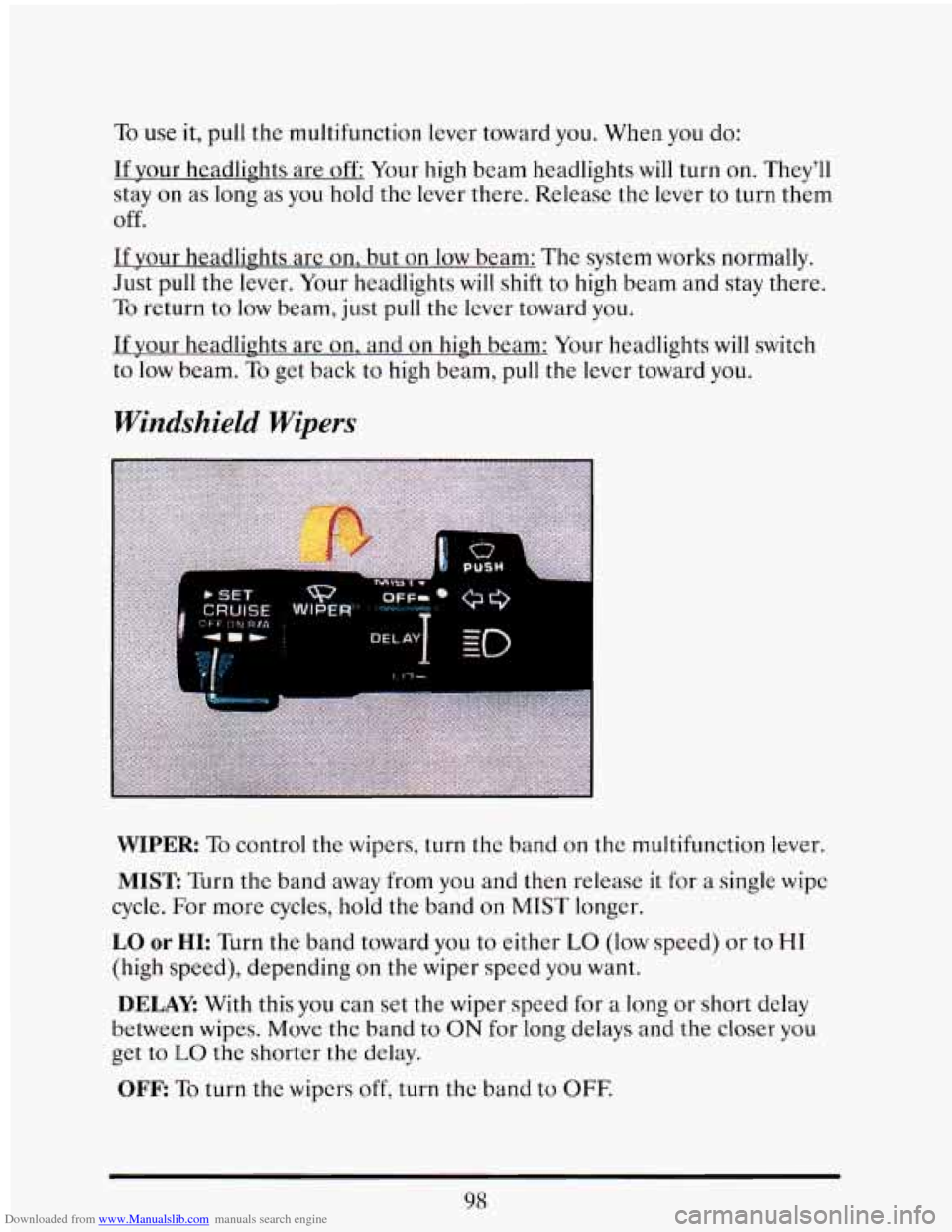
Downloaded from www.Manualslib.com manuals search engine To use it, pull the multifunction lever toward you. When you do:
If your headlights are off Your high beam headlights will turn on. They’ll
stay
on as long as you hold the lever there. Release the lever to turn them
off.
If your headlights are on. but on low beam: The system works normally.
Just pull the lever. Your headlights
will shift to high beam and stay there.
To return to low beam, just pull the lever toward you.
If your headlights are on. and on high beam: Your headlights will switch
to low beam.
To get back to high beam, pull the lever toward you.
Windshield Wipers
WIPER To control the wipers, turn the band on the multifunction lever.
MIST: Turn the band away from you and then release it for a single wipe
cycle. For more cycles, hold the band
on MIST longer.
LO or HI: Turn the band toward you to either LO (low speed) or to HI
(high speed), depending on the wiper speed you want.
DELAY: With this you can set the wiper speed for a long or short delay
between wipes. Move the band to ON for long delays and the closer you
get to LO the shorter the delay.
OFF: To turn the wipers off, turn the band to OFF.
98
Page 121 of 398

Downloaded from www.Manualslib.com manuals search engine Twilight Sentinel
The control is next to the headlight switch. It switches your lights on and
off by sensing how dark
it is outside. To operate it, leave the light switch
off and move the control
to any position but off.
If you move the control all the way to MAX, your lights will remain on for
90 seconds after you turn your engine off. If you move the control almost
all the way in the other direction,
so it is just on, the lights will go off
quickly when you turn off your engine. You can change this delay time
from
only a few seconds to 90 seconds.
Operation of Lights
Although your vehicle’s lighting system (headlamps, parking lamps, fog
lamps, side marker lamps and tail lamps) meet all applicable Federal
lighting requirements, certain States and Provinces may apply their own
lighting regulations that may require special attention before
you operate
these lamps. For example, some jurisdictions may require that
you
operate your lower beam lamps with fog lamps at all times, or that
headlamps be turned on whenever
you must use your windshield wipers.
In addition, most jurisdictions prohibit driving solely with parking lamps,
especially at dawn
or dusk. It is recommended that you check with your
own State or Provincial highway authority for applicable lighting
regulations.
107
Page 123 of 398
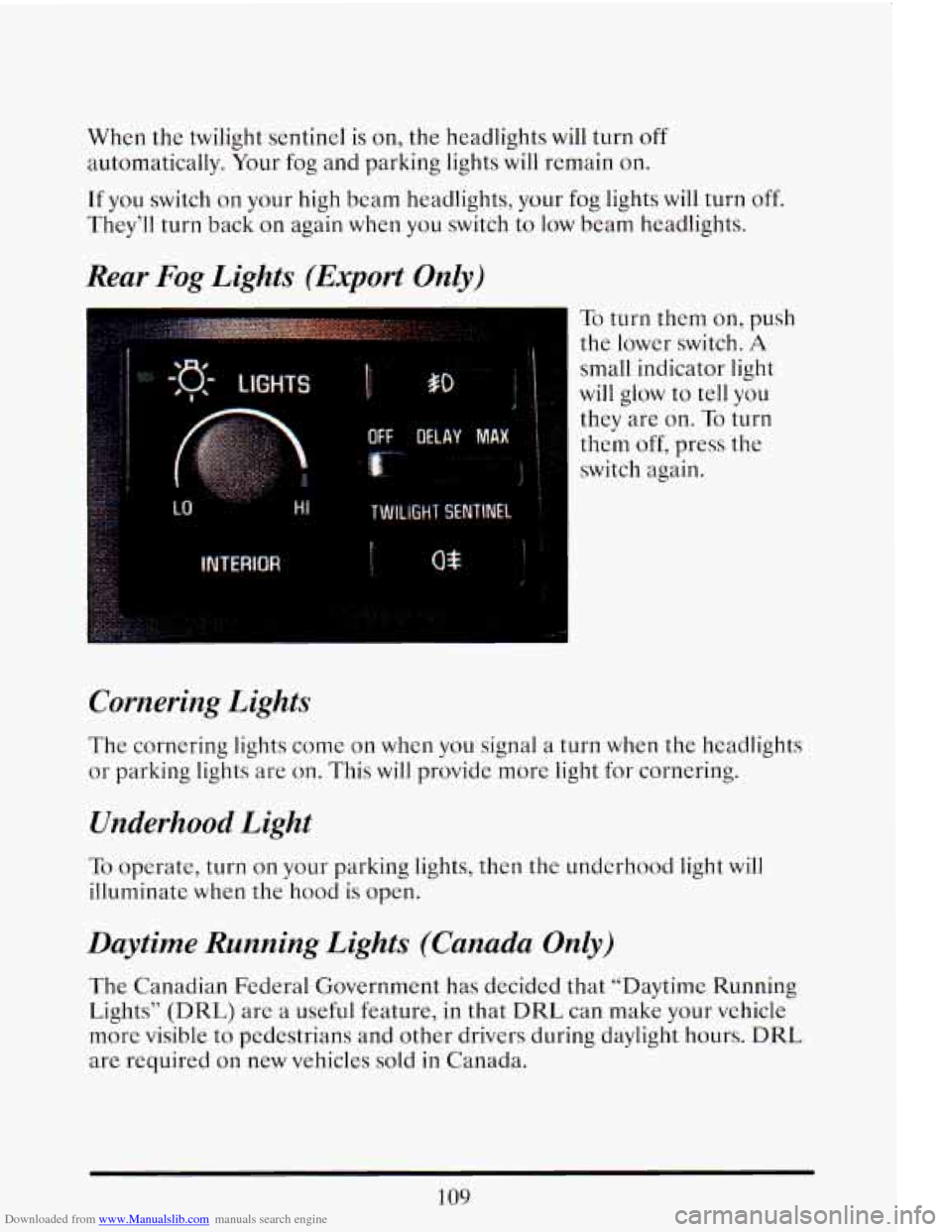
Downloaded from www.Manualslib.com manuals search engine When the twilight sentinel is on, the headlights will turn off
automatically. Your fog and parking lights will remain on.
If you switch on your high beam headlights, your fog lights will turn off.
They’ll turn back on again when
you switch to low beam headlights.
Rear Fog Lights (Export Only)
To turn them on, push
the lower switch.
A
small indicator light
will glow to tell you
they are on. To turn
them
off, press the
switch again.
Cornering Lights
The cornering lights come on when you signal a turn when the headlights
or parking lights are on. This will provide more light for cornering.
Underhood Light
To operate, turn on your parking lights, then the underhood light will
illuminate when the hood is open.
Daytime Running Lights (Canada Only)
The Canadian Federal Government has decided that “Daytime Running
Lights”
(DRL) are a useful feature, in that DRL can make your vehicle
more visible to pedestrians and other drivers during daylight hours.
DRL
are required on new vehicles sold in Canada.
109
Page 124 of 398
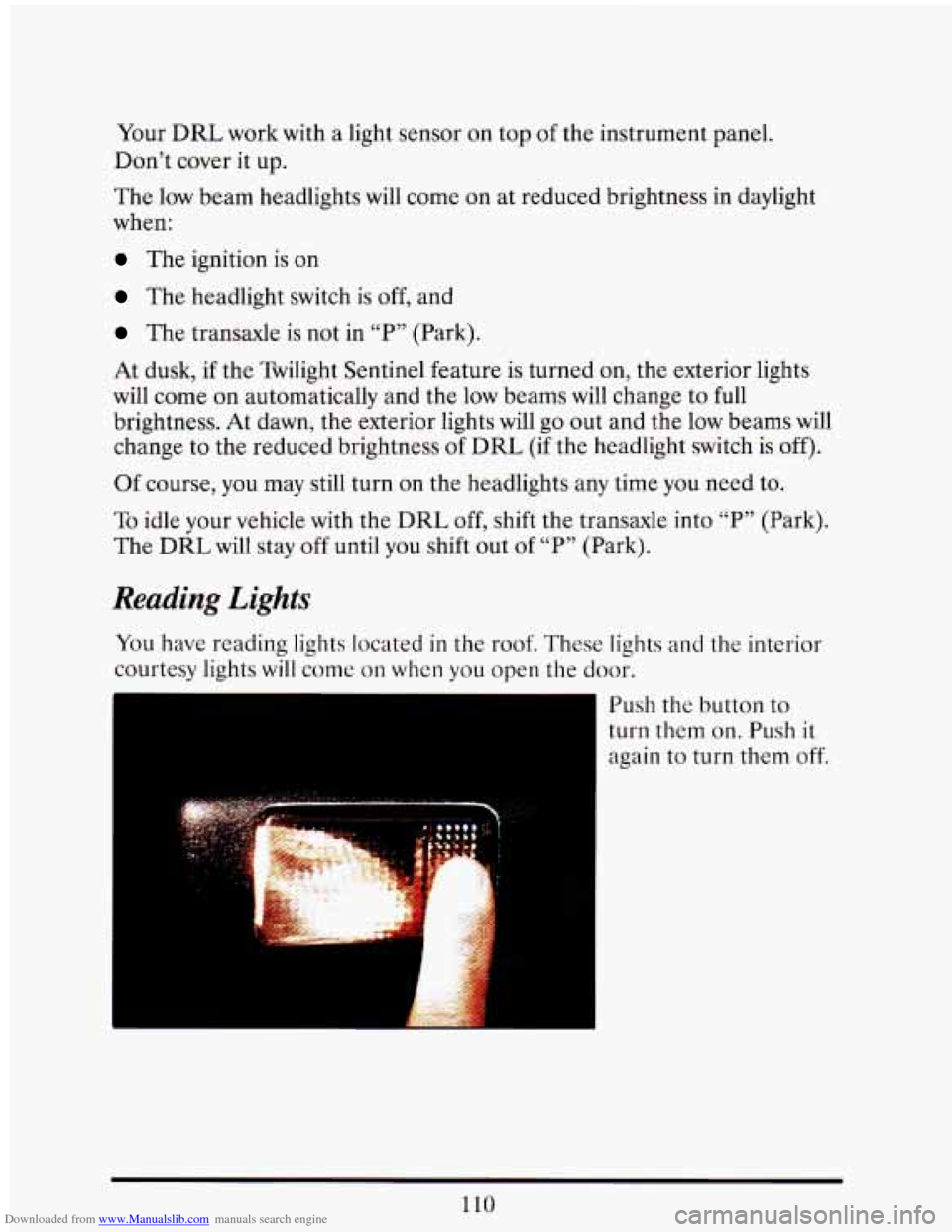
Downloaded from www.Manualslib.com manuals search engine Your DRL work with a light sensor on top of the instrument panel.
Don’t cover
it up.
The low beam headlights will come on at reduced brightness in daylight
when:
The ignition is on
The headlight switch is off, and
The transaxle is not in “P” (Park).
.At dusk,
if the Twilight Sentinel feature is turned on, the exterior lights
will come on automatically and the
low beams will change to full
brightness. At dawn, the exterior lights will go out and the low beams will
change to the reduced brightness
of DRL (if the headlight switch is off).
Of course, you may still turn on the headlights any time you need to.
To idle your vehicle with the DRL off, shift the transaxle into “P” (Park).
The
DRL will stay off until you shift out of “P” (Park).
Reading Lights
You have reading lights located in the roof. These lights and the interior
courtesy lights
will come on when you open the door.
Push the button
to
turn them on. Push it
again to turn them off.
110
Page 197 of 398

Downloaded from www.Manualslib.com manuals search engine Steering Tips
Driving on Curves
It’s important to take curves at a reasonable speed.
A lot of the “driver lost control” accidents mentioned on the news
happen on curves. Here’s why:
Experienced driver or beginner, each of
us is subject to the same laws of
physics when driving on curves. The traction
of the tires against the road
surface makes it possible for the vehicle to change its path
when you turn
the front wheels. If there’s
no traction, inertia will keep the vehicle going
in the same direction.
If you’ve ever tried to steer a vehicle on wet ice,
you’ll understand this.
The traction you can get in a curve depends on the condition
of your tires
and the road surface,
the angle at which the curve is banked, and your
speed. While you’re in a curve, speed is the one factor you can control.
Suppose you’re steering through
a sharp curve. Then you suddenly
accelerate.
Those two control systems -- steering and acceleration -- can overwhelm
those places where the tires meet the road and make you lose control.
What should you do if this ever happens? Let up on the accelerator
pedal, steer the vehicle the way
you want it to go, and slow down.
Speed limit signs near curves warn that you should adjust your speed.
Of
course, the posted speeds are based on good weather and road
conditions. Under less favorable conditions you’ll want to go slower.
If you need to reduce your speed as you approach
a curve, do it before
you enter the curve, while your front wheels are straight ahead.
Try to adjust your speed so you can “drive” through the curve. Maintain a
reasonable, steady speed. Wait to accelerate until you are out
of the
curve, and then accelerate gently into the straightaway.
When you drive into a curve at night, it’s harder to see the road ahead of
you because it bends away from the straight beams of your lights. This is
one good reason
to drive slower.
183
Page 204 of 398

Downloaded from www.Manualslib.com manuals search engine dark. When you are faced with severe glare (as from a driver who doesn’t
lower the high beams, or a vehicle with misaimed headlights), slow down
a little. Avoid staring directly into the approaching lights. If there
is a line
of opposing traffic, make occasional glances over the line
of headlights to
make certain that one
of the vehicles isn’t starting to move into your lane.
Once
you are past the bright lights, give your eyes time to readjust before
resuming speed.
High Beams
If the vehicle approaching you has its high beams on, signal by flicking
yours to high and then back to low beam. This is the usual signal
to lower
the headlight beams. If the other driver still doesn’t lower the beams,
resist the temptation to put your high beams on. This only makes two
half-blinded drivers.
On a freeway, use your high beams only in remote areas where you won’t
impair approaching drivers. In some places, like cities, using high beams
is illegal.
When you
follow another vehicle on a freeway or highway, use low
beams. True, most vehicles now have day-night mirrors that enable the
driver
to reduce glare. But outside mirrors are not of this type and high
beams from behind can bother the driver ahead.
A Few More Night Driving Suggestions
Keep your windshield and all the glass on your vehicle clean -- inside and
out. Glare at night
is made much worse by dirt on the glass. Even the
inside
of the glass can build up a film caused by dust. Tobacco smoke also
makes inside glass surfaces
very filmy and can be a vision hazard if it’s left
there.
Dirty glass makes lights dazzle and flash more than clean glass would,
making the pupils
of your eyes contract repeatedly. You might even want
to keep a cloth and some glass cleaner in your vehicle if you need to clean
your glass frequently.
Remember that your headlights light up far less of a roadway when you
are
in a turn or curve.
Keep your eyes moving; that way, it’s easier to pick out dimly lighted
objects.
190